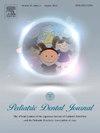唐氏综合征人脱落乳牙牙髓干细胞基因表达谱的研究
IF 0.8
Q4 DENTISTRY, ORAL SURGERY & MEDICINE
引用次数: 0
摘要
目的唐氏综合征是由21号染色体三体引起的,在器官上表现出多种表型。唐氏综合征患者常出现牙齿畸形,如牙髓缺损、牙釉质发育不全等,但与唐氏综合征相关的牙齿畸形机制尚不清楚。为了阐明唐氏综合征牙齿表型的细节,我们对人脱落乳牙(SHED)的牙髓干细胞进行了rna -序列(RNA-seq)分析。材料与方法选取唐氏综合征患儿3例作为患者组,健康儿童3例作为对照组。在5岁至8岁期间,从拔除的牙齿中收集牙髓,并培养SHED。采用RT-qPCR验证该基因在21号染色体上的表达水平是否存在差异。MTT法和集落形成法检测细胞增殖能力。采用RNA-seq综合分析对照组与唐氏综合征组基因表达差异。结果对照组和唐氏综合征组的shed在细胞形态和增殖活性上无显著差异,而COL6A1的表达在唐氏综合征组上调1.5倍左右,提示21号染色体基因发生三体。RNA-seq分析显示,与器官形态发生相关的基因表达上调。此外,几个对牙齿发育重要的基因被上调为显著的基因。结论SHED基因分析是阐明唐氏综合征牙畸形发生机制的有效工具。本文章由计算机程序翻译,如有差异,请以英文原文为准。
Characterization of gene expression profile of dental pulp stem cells from human exfoliated deciduous teeth (SHED) in down syndrome
Objectives
Down syndrome is caused by trisomy of chromosome 21 and shows various phenotype in organs. The patients often suffer dental anomalies such as hypodontia and enamel hypoplasia, however, the mechanism of dental anomalies associated to Down syndrome remains unclear. To clarify the details of the dental phenotype of Down syndrome, we performed RNA-sequence (RNA-seq) of dental pulp stem cells from human exfoliated deciduous tooth (SHED).
Materials and methods
Three children with Down syndrome were selected as the patient group, and three healthy children were selected as the control group. Dental pulp was collected from extracted teeth during the replacement period between the ages of 5 and 8, and SHED was cultured. RT-qPCR was used to confirm whether there was a difference in the expression level of the gene on chromosome 21. MTT assay and colony formation assay was performed to examine cell proliferation ability. RNA-seq was performed to comprehensively analyze the gene expression difference between control group and Down syndrome group.
Results
SHED of control group and Down syndrome group showed no significant difference in cell shape and proliferation activity, while, the expression of COL6A1 was around 1.5-fold change upregulated in Down syndrome group, suggesting that the gene of chromosome 21 became trisomy. RNA-seq analyses revealed that the genes related to organ morphogenesis were upregulated. Furthermore, several genes important for tooth development was raised as significantly upregulated genes.
Conclusion
Genetic analysis using SHED was considered a useful tool for elucidating the mechanisms of dental anomalies in Down syndrome.
求助全文
通过发布文献求助,成功后即可免费获取论文全文。
去求助
来源期刊

Pediatric Dental Journal
DENTISTRY, ORAL SURGERY & MEDICINE-
CiteScore
1.40
自引率
0.00%
发文量
24
审稿时长
26 days
 求助内容:
求助内容: 应助结果提醒方式:
应助结果提醒方式:


